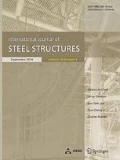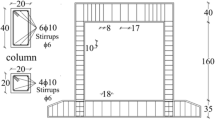Abstract
This study is focussed on the evaluation of seismic performance of concentrically steel braced frames (CBFs) designed using direct displacement-based (DDBD) method. Design displacement profile in this method is derived from the inelastic mode shape normalized based on first story displacement. Design base shear of a structure is determined using design displacement spectrum and the equivalent viscous damping. Two low- and medium-rise CBFs, namely, 3-story and 6-story, are designed using DDBD method as well as current practice. These study frames are modelled and analysed in a computer software OpenSEES to compare their seismic performance under a set of selected ground motions. Braces are modelled using force-based fibre-discretized non-linear beam-column elements simulating the effects of inelastic buckling, large strain and low-cycle fatigue. The main parameters investigated are the maximum story displacements, the interstory drifts, the residual drifts and the yield mechanisms. DDBD frames exhibited the improved seismic response as compared to those design as per current practice.











Similar content being viewed by others
References
ANSI/AISC 341-10. (2010). Seismic provisions for structural steel buildings. Chicago, IL: American Institute of Steel Construction.
ASCE 7-10. (2010). Minimum design loads for buildings and other structures. Reston, VA: American Society of Civil Engineers.
Chao, S.-H., Karki, N. B., & Sahoo, D. R. (2013). Seismic behavior of steel buildings with hybrid braced frames. ASCE Journal of Structural Engineering, 139(6), 1019–1032.
Chopra, A. K. (1995). Dynamics of structures: Theory and applications to earthquake engineering. Upper Saddle River, NJ: Prentice Hall.
Della Corte, G, & Mazzolani, F. M. (2008). Theoretical developments and numerical verification of a displacement-based design procedure for steel braced structures. In Proceedings of the 14th world conference on earthquake engineering, Beijing.
Eurocode 8. (2009). Design of structures for earthquake resistance—Part 1: general rules, seismic actions and rules for buildings, EN 1998-1:2004/AC:2009, Brussels.
Fajfar, P. (1998). Capacity spectrum method based on inelastic demand spectra. IKPIR Report EE-3/98, University of Ljubljana, Slovenia.
Fajfar, P., & Gašperšič, P. (1996). The N2 method for the seismic damage analysis of RC buildings. Earthquake Engineering and Structural Dynamics, 25(1), 31–46.
FEMA 273. (1997). NEHRP guidelines for the seismic rehabilitation of buildings. Washington, DC: Federal Emergency Management Agency.
FEMA 356. (2000). Pre-standard and commentary for the seismic rehabilitation of buildings (p. 2000). Washington, DC: Federal Emergency Management Agency.
Ghobarah, A. (2001). Performance-based design in earthquake engineering: state of development. Engineering Structures, 23, 878–884.
Goel, S. C. & Chao, S. H. (2008). Performance-based plastic design-earthquake resistant steel structures. International Code Council.
Goggins, J. G., & Sullivan, T. J. (2009). Displacement-based seismic design of SDOF concentrically braced frames. In F. Mazzolani, J. M. Ricles & R. Sause (Eds.), STESSA 2009 (pp. 685–692). Milton Park: Taylor & Francis Group.
Kumar, P. C. A., & Sahoo, D. R. (2016). Optimum range of slenderness ratio of HSS braces for special concentric braced frames. Advances in Structural Engineering, 19(6), 928–944.
Kumar, P. C. A., Sahoo, D. R., & Kumar, N. (2015). Limiting values of slenderness ratio for circular braces of concentrically braced frames. Journal of Constructional Steel Research, 115, 223–235.
Lee, H.-S., & Goel, S. C. (1990). Seismic behavior of steel built-up box shaped bracing members and their use in strengthening reinforced concrete frames. Rep. No. UMCE 90-7, Dept. of Civil and Environmental Engineering, Univ. of Michigan, Ann Arbor, MI.
McKenna, F., Fenves, G. L., Jeremic, B., & Scott, M. H. (2007). Open system for earthquake engineering simulation (OpenSEES). Berkeley, CA: University of California.
O’Reilly, G., Goggins, J., & Mahin, S. (2012). Performance-based design of a self-centering concentrically braced frame using the direct displacement-based design procedure. In Proceedings of the 15th world conference on earthquake engineering. Lisbon, Portugal.
Priestley, M. J. N. (2000). Performance-based seismic design. In Proceeidngs of the 12th world conference on earthquake engineering, Auckland.
Priestley, M. J. N., Calvi, G. M., & Kowalsky, M. J. (2007). Displacement-based seismic design of structures (p. 721). Pvia: IUSS Press.
Sabelli R. (2000). Research on improving the design and analysis of earthquake resistant steel braced frames. FEMA/EERI report, Federal Emergency Management Agency, Washington, DC.
Sahoo, D. R., & Chao, S.-H. (2010). Performance-based plastic design of buckling-restrained braced frames. Engineering Structures, 32(9), 2950–2958.
Sahoo, D. R., & Rai, D. C. (2013). Design and evaluation of seismic strengthening techniques for RC buildings with soft-story. Engineering Structures, 56(11), 1933–1944.
Salawdeh, S., & Goggin, J. G. (2012). Direct displacement based seismic design of multi-storey concentrically braced frame structures. IABSE symposium report, global thinking in structural engineering: Recent achievements, (Vol. 98, No. 1, pp. 1–8). International Association for Bridge and Structural Engineering.
Salawdeh, S., & Goggins, J. (2013). Numerical model for steel brace members incorporating brace members incorporating a fatigue model. Engineering Structures, 46, 332–349.
Somerville P. G., Smith M., Punyamurthula S., & Sun J. (1997). Development of ground motion time histories for phase 2 of the FEMA/SAC steel project. Report No. SAC/BD-97/04, Sacramento, CA.
Tang, X., & Goel, S. C. (1987). Seismic analysis and design considerations of braced steel structures. Report No. UMCEE 87-04, Department of Civil Engineering, University of Michigan, MI, USA.
Tremblay, R. (2002). Inelastic seismic response of steel bracing members. Journal of Constructional Steel Research, 58, 665–701.
Uriz, P., Filippou, F. C., & Mahin, S. A. (2008). Model for cyclic inelastic buckling of steel braces. ASCE Journal of Structural Engineering, 134, 619–628.
Wijesundara, K. (2009). Design of concentrically braced steel frames with RHS shape braces. Doctoral thesis, European Centre for Training and Research in Earthquake Engineering (EUCENTRE), Pavia, Italy.
Wijesundara, K. K. (2012). Seismic design of steel concentric braced frame structures using direct displacement based design approach. In Proceedings of the 2nd international conference on sustainable built environments (ICSBE 2012), Sri Lanka.
Wijesundara, K. K., Nascimbene, R., & Sullivan, T. J. (2011). Equivalent viscous damping for steel concentrically braced frame structures. Bulletin of Earthquake Engineering, 9(5), 1535–1558.
Author information
Authors and Affiliations
Corresponding author
Rights and permissions
About this article
Cite this article
Sahoo, D.R., Prakash, A. Seismic behavior of concentrically braced frames designed using direct displacement-based method. Int J Steel Struct 19, 96–109 (2019). https://doi.org/10.1007/s13296-018-0092-0
Received:
Accepted:
Published:
Issue Date:
DOI: https://doi.org/10.1007/s13296-018-0092-0




